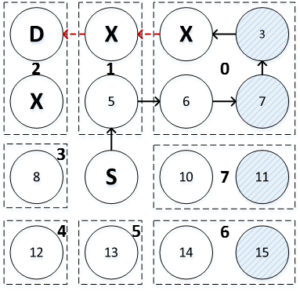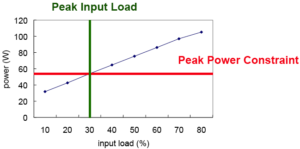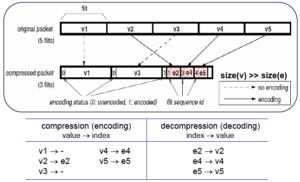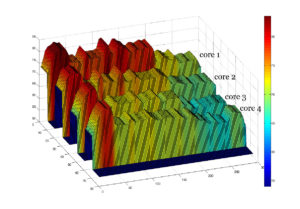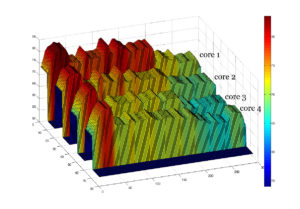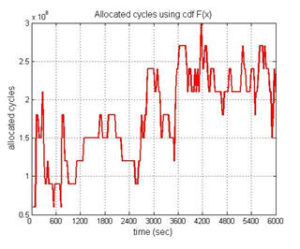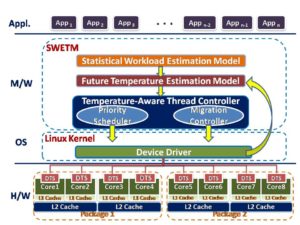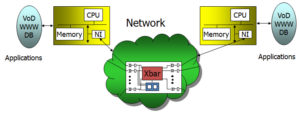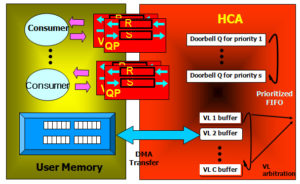Multicore Accelerators like GPUs have recently obtained attention as a cost-effective approach for data parallel architectures, and the fast scaling of the GPUs increases the importance of designing an ideal on-chip interconnection network, which impacts the overall system performance. Since shared buses and crossbar can provide networking performance enough only for a small number of communication nodes, switch-based networks-on-chip (NoCs) have been adopted as an emerging design trend in many-core environments. However, NoC for Multicore Accelerator architectures has not been extensively explored. While the major communication of Chip Multiprocessor (CMP) systems is core-to-core for shared caches, major traffic of Multicore Accelerators is core-to-memory, which makes the memory controllers hot spots. Also, since Multicore Accelerators execute many threads in order to hide memory latency, it is critical for the underlying NoC to provide high bandwidth.
In this project, we develop a framework for high-performance, energy-efficient on-chip network mechanisms in synergy with Multicore Accelerator architectures. The desirable properties of a target on-chip network include re-usability across a wide range of Multicore Accelerator architectures, maximization of the use of routing resources, and support for reliable and energy-efficient data transfer.
Approximate Network-on-Chip Architectures
Approximate Computing has emerged as an attractive alternate compute paradigm by trading off computation accuracy for benefits in both performance and energy efficiency. Approximate techniques rely on the ability of applications and systems to tolerate imprecision/loss of quality in the computation results. Many emerging applications in machine learning, image/video processing and pattern recognition have already employed approximation to achieve better performance. A significant portion of research on approximate hardware has focused on either computation units for accelerated inaccurate execution, or memory hierarchy for high performance memory. However, there has been no prior research on approximate communication for the interconnection fabric of manycore systems.
Networks-on-Chip (NoCs) have emerged as the most competent communication fabric to connect an ever increasing number of processing/memory elements. Communication-centric applications such as image/video processing and emerging memory intensivie big-data workloads place a significant amount of stress on the NoC for high throughput. Hence, designing a high-performance NoC to provide high throughput has become critical to overall system performance. Therefore, the need to explore hardware approximation techiques that can leverage the modern approximate computing paradigm for high-throughput NoCs is imminent.
In this work we propose APPROX-NoC, a data approximation framework for NoCs to alleviate the impact of heavy data communication stress by leveraging the error tolerance of applications. APPROX-NoC proposes to reduce the transmission of approximately similar data in the NoC by delivering approximated versions of precise data to improve the data locality for higher compression rate. We design a data-type aware value approximation engine (VAXX), with a light weight error margin compute logic, which can be used in the manner of plug and play module for any underlying NoC data compression mechanisms. VAXX approximates the value of a given data block to the closest compressible data pattern based on the data type, with fast quantitative error margin calculation, thereby improve network throughput.

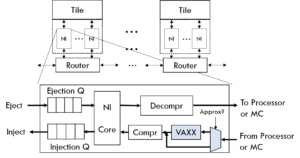
APPROX-NOC Main Idea and Architecture Overview

Approximate Value Compute Logic
Power-Gating for Energy-Efficient Networks-on-Chip
Chip Multiprocessors (CMPs) are scaling to 100s and 1000s cores owing to shrinking transistor sizes and denser on-chip packaging as stated by Moore’s law. However, the failure of Dennard Scaling, supply voltage not scaling down with the transistor size, exposes high risks to break the power and thermal constraints to keep all on-chip components switching simultaneously. The future CMP designs will have to work under stricter power envelops. Scalable Networks-on-Chip (NoCs), like 2D meshes, have become de facto interconnection mechanism in large scale CMPs. Recent studies have shown that NoCs consume a significant portion of the total on-chip power budget, ranging from 10% to 36%. Hence, power-efficient NoCs designs are of the highest priority for power-constrained future CMPs.
Static power consumption of the on-chip circuitry is increasing at an alarming rate with the chip circuitry is increasing at an alarming rate with the scaling down of feature sizes and chip operating voltages towards near threshold levels. As we reach towards sub-10nm feature sizes, static power will become the major portion of the NoC power consumption. Power-gating, cutting off supply current to idle chip components, is an effective technique that can be used to mitigate the worsening impact of on-chip static power consumption. However, applying power-gating for NoCs may disconnect the network and lead to performance degradation.
We propose Fly-Over (FLOV), a light-weight distributed power-gating mechanism for energy-efficient NoCs. FLOV tries to power-gate idle routers in a distributed manner through handshake protocols. FLOV routers provides FLOV links for packets to fly-over gated routers with a dynamic best-effort shortest routing algorithm in order to facilitate network functionalities and sustain performance.
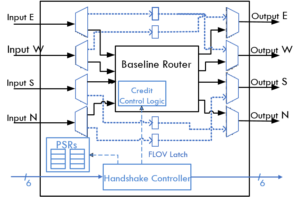
FLOV Router Architecture
FLOV Routing Example

Application Execution Time for PARSEC Benchmarks

Application Energy Consumption for PARSEC Benchmarks
Bandwidth Efficient On-Chip Interconnect Designs
GPGPUs are characterized by numerous programmable computational cores which allow for thousands of simultaneous active threads to execute in parallel. The advent of parallel programming models, such as CUDA and OpenCL, makes it easier to program graphics/non-graphics applications, making GPGPUs an excellent computing platform. The growing quantity of parallelism and the fast scaling of GPGPUs have fueled an increasing demand for performance-efficient on-chip fabrics finely tuned for GPGPU cores and memory systems.
Ideal interconnects should minimize message blocking by efficiently exploiting limited network resources such as virtual channels (VCs) and physical channels (PCs) while ensuring deadlock freedom. Switch-based Networks-on-Chip (NoCs) have been useful in manycore chip-multiprocessor (CMP) environments for their scalability and flexibility. Unlike CMP systems where NoC traffic tends to be uniformly divided up across cores communicating with distributed on-chip caches, the communication in GPGPUs is highly asymmetric, mainly between many compute cores and a few memory controllers (MCs) on a chip. Thus the MCs often become hot spots, leading to skewed usage of significant portions of the NoC resources such as wires and buffers. Specifically, heavy reply traffic from MCs to cores potentially causes a network bottleneck, degrading the overall system performance. Therefore when we design a bandwidth-efficient NoC, the asymmetry of its on-chip traffic must be considered.
The throughput-effectiveness is a crucial metric for improving the overall performance in throughput-oriented architectures, thus designing a high bandwidth NoC in GPGPUs is of primary importance. Thus, to achieve such a goal, we quantitatively analyze the impact of network traffic patterns in GPGPUs with different MC placements and dimension order routing algorithms. Then, motivated by the detailed analysis, we propose VC monopolizing and partitioning schemes which dramatically improve NoC resource utilization without causing protocol deadlocks. We also investigate the impact of different routing algorithms under diverse MC placements.

Packet Type Distribution for GPGPU Benchmarks


Network traffic examples with XY and XY-YX routing
Publications
- Approx-NoC: A Data Approximation Framework for Network-On-Chip Architectures,
R. Boyapati, J. Huang, P. Majumdar, K. H. Yum and E. J. Kim,
The 44th International Symposium on Computer Architecture (ISCA), June, 2017 - Fly-Over: A Light-Weight Distributed Power-Gating Mechanism for Energy-Efficient Networks-on-Chip,
R. Boyapati*, J. Huang*, N. Wang, K. H. Kim, K. H. Yum and E. J. Kim,
The 31st IEEE International Parallel & Distributed Processing Symposium (IPDPS), June, 2017 - Bandwidth Efficient On-Chip Interconnect Designs for GPGPUs,
H. Jang, J. Kim, P. Gratz, K. H. Yum, and E. J. Kim,
The 52nd Design Automation Conference (DAC), June 2015

